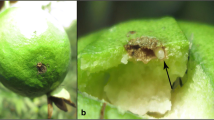Abstract
Due to the traditionally employed methods, a number of unmanageable factors cause difficulties in the prognosis of voles. To avoid these problems to a great deal, the employment of elements of the natural food as indicator for vole-abundancy seems the most promising way. Freshly cut twigs from apple-trees result highly attractive for voles during autumn and winter. Upright exposure during one to two weeks in a representative distribution over the area of study allows the establishment of:
-
- the simple percentage of damaged twigs for rough prognosis purposes;
-
- a direct indicator for the present vole-population may be obtained through calculation of a relative value-of-damage for more detailed purposes. For more details see summary.
Similar content being viewed by others
Literatur
Eckhardt, M., 1990: Untersuchungen zur Vorverlegung von Mäuse-Probefängen. Dipl.-Arb. Fachhochschule Hildesheim Holzminden, Fachber. Forst.
Gonschorrek, J., 1989: Zur Verbesserung der Schadprognose für Erd- und Rötelmäuse (Microtus agrestis L. undClethrionomys glareolus Schreb.). Diss. Forstwiss. Fachber. Univ. Göttingen.
Niemeyer, H., 1993: Wichtige Forstschädlinge erkennen, überwachen und bekämpfen. Auswertungs- u. Informationsdienst f. Land- u. Forstwirtschaft (AID) — Heft Nr.:1208.
Niemeyer, H., 1993: Neue Konzeption zur Bekämpfung der Erdmaus (Microtus agrestis L.) in forstlichen Verjüngungen Norddeutschlands. Anz. Schädlingskde., Pflanzenschutz, Umweltschutz66, 41–46.
Niemeyer, H.; Krüger, F. et al., 1995: Richtlinie für die Prüfung von Mitteln gegen Nagetiere im Forst; Richtlinien für die Prüfung von Pflanzenschutzmitteln im Zulassungsverfahren, Teil II, Nr.: 18-31 (Entwurf), Biologische Bundesanstalt für Land- und Forstwirtschaft, Braunschweig.
Niemeyer, H.;Schmidt, U.;Krüger, F., 1994: Tierschutz-und Artenschutzaspekte beim Mäuse-Probefang mit Schlagfallen. Forst und Holz49, 595–597.
Niemeyer, H.;Watzek, G., 1992: Die Unzuverlässigkeit der Erdmausprognose erfordert neues Bekämpfungskonzept. Forst und Holz47, 198–200.
Schmidt, U., 1994: Untersuchungen zur Prognosetechnik und Möglichkeiten einer rodentizidfreien Bekämpfung forstschädlicher Mäuse. Dipl. Arb., Fachhochschule Hildesheim Holzminden, Fachber. Forst.
Author information
Authors and Affiliations
Additional information
Mit 3 Abbildungen
Rights and permissions
About this article
Cite this article
Krüger, F. Steckhölzer für die Abundanz- und Schadprognose oberirdisch fressender Kurzschwanzmäuse (Microtinae), eine Alternative zum Fallenfang. Anz. Schadlingskde., Pflanzenschutz, Umweltschutz 69, 130–135 (1996). https://doi.org/10.1007/BF01904714
Issue Date:
DOI: https://doi.org/10.1007/BF01904714




